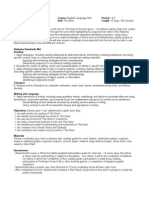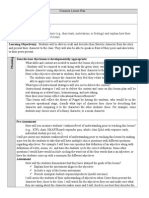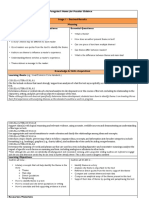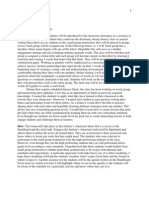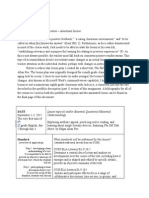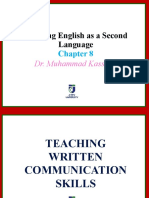Ca 2
Ca 2
Uploaded by
AJMcRostCopyright:
Available Formats
Ca 2
Ca 2
Uploaded by
AJMcRostOriginal Description:
Original Title
Copyright
Available Formats
Share this document
Did you find this document useful?
Is this content inappropriate?
Copyright:
Available Formats
Ca 2
Ca 2
Uploaded by
AJMcRostCopyright:
Available Formats
Direct Instruction
Presentation w/ Adv Organizer
Concept Attnment
Cooperative Learning
Inquiry Teaching
Concept Attainment Lesson Plan (10 pts) Lesson Background:
Your Name: Jeff Rost Subject: (circle one) Lesson Title: Metaphors Materials Needed: Paper, pencils, examples of metaphors, examples of phrases that are not metaphors, Youre Toast book. Prerequisite Skills: Students will need to have a basic understanding of the parts of speech. Lesson Objective: Students will identify metaphors within a text and examples given Students will understand the differences between metaphors, similes, and idioms Students will create metaphors of their own Concept Label: Figure of speech between two unlike objects and/or ideas Critical Attributes: [yes] Phrases, sentences, examples, paragraphs utilizing metaphors as figures of speech Non-critical Attributes [no] Phrases, sentences, examples, paragraphs utilizing non-metaphors as figures of speech (similes, idioms, etc) Language Arts Grade Level: (circle one) K 1 2 3 4 5 6 Social Studies Mathematics Science
Definition of Concept: A metaphor is a figure of speech where an object is analogously described by means of comparing it to another unrelated object. ----------------------------------------------------------------------------------------------------------------------------- -----
Interaction with Students:
1. Provide examples and non-examples to the class: (Distinguish yes/no attributes) Time 20 mins I will explain to the class that we will be learning about metaphors. I will ask the class if anyone knows what a metaphor is. Once answers are given, I will explain that a metaphor is a figure of speech that analogously compares two or more seemingly unrelated objects and/or ideas. I will provide the class with three examples of metaphors and will write them on the white board. I will then briefly discuss similes and what diffentiates the two. I will then read the book Youre Toast to the class, and after we have read the book, we will discuss what metaphors they observed in the text. 2. Test for attainment: (Do the students understand the concept?) Time: 10 mins I will monitor student work during our practice and will provide assistance to students who are struggling before or during independent practice to ensure student understanding. Once I have read the text and identified any students who may be struggling, I will use overhead sheets/documents on the document camera to show examples and non-examples of metaphors to the class. This list will contain approximately 6 examples, with 3 metaphors and 3 non-metaphors (similes, idioms, etc). I will read the metaphor to the class, and will ask them to write down on a sheet of paper if they thought the example was a metaphor or not a metaphor. I will explain that they will be turning this in to me (I wont be grading it, but I want to ensure that all students are thinking about the examples as we progress through them as a class). After each example, we
will talk about what students thought it was. We will discuss each example, and what either made it a metaphor, or disqualified it as a metaphor and classified it as something else. 3. Analyze student thinking processes and integration of learning: Time: 10 mins (Are they able to provide additional examples and non-examples?) After we have worked together identifying metaphors from Youre Toast and examples I have provided, I will ask students to work in small groups to create/find metaphors of their own. I will pair the students based on readiness/ability and will notify students of their group assignment before this activity. I will tell the students that in their small groups, they are to create as many metaphors as they can during the time allotted. I will also give them the option of finding metaphors in their current free reading books or in books from the class library. During this time, I will walk around the room and monitor student progress, assisting students when necessary. 4. Clarify lesson objectives: (What are students going to DO with these?) Time: 10 mins Once the students have shared the metaphors they came up with in groups, I will ask for student input on why metaphors are essential in literature. I will ask students to think about the metaphors they create on a daily basis, and will point out that literature might be boring if it never included metaphors. 5. Procedures for Using the Concept in a meaningful way? See above for in-class work and below for assessment. 6. Assessment / Closure (How do you evaluate student progress or provide closure for this lesson?) Include rubric, checklist, assessment documents. Time: 10 mins For closure, I will ask the students to create a set of metaphors to turn in to me. Those questions are below.
Metaphors
Name:
______________________________
You are going to create two metaphors. Remember the rules of a metaphor, and include plenty of details.
1.
Create a metaphor to explain your favorite birthday memory.
2.
Crete a metaphor to explain how you felt during your first day of
school this year.
7. DIFFERENTIATION of Content, Process or Product: a. Adaptation for students who need extra help, time, or attention? For students who are struggling, I will work with them and have them start by identifying and creating similes. I will explain to them the process of building metaphors from similes and will give them several examples. I will work with them to create similes in a small group, and we will then work up to creating metaphors. b. Extension for students of high ability ? (Remember, assigning gifted students to be the tutor for others is not sufficient academic challenging for students who have mastered the lesson). For students with high ability, I will ask that they create a short story incorporating similes, metaphors and idioms, expanding on todays lesson. I will ask them to incorporate at least three of each, and will ask that they complete the story using a given theme. TOTAL LESSON TIME:__60 mins____ 8. References Consulted (Curriculum books in Drake SOE curriculum lab, previous teachers as resources, online websites, your past experiences, or your own initiatives, etc): Loewen, N. (2011). Youre Toast and Other Metaphors We Adore. Picture Window Books. During elementary school I had a difficult time discerning between metaphors and similes. When thinking about concept attainment, I decided I wanted to create a lesson plan within language arts, and I decided upon metaphors. I love incorporating literature into as many lessons as possible, so I found the book Youre Toast and thought it would be perfect for this lesson. I wanted to provide as many opportunities for students to work individually and cooperatively while engaging with this figure of speech and its prevalence in the literature they read.
You might also like
- The Giver Unit PlanDocument11 pagesThe Giver Unit PlanStephanie Vasse94% (16)
- Shared Reading Lesson Plan FormatDocument13 pagesShared Reading Lesson Plan Formatapi-296389786No ratings yet
- Civil War Five Lesson UnitDocument21 pagesCivil War Five Lesson UnitAJMcRostNo ratings yet
- English File: Grammar, Vocabulary, and PronunciationDocument15 pagesEnglish File: Grammar, Vocabulary, and PronunciationLeya STU100% (1)
- Speaking and Listening Lesson PlanDocument4 pagesSpeaking and Listening Lesson Planapi-296333288No ratings yet
- 477 Lesson Plan Summer 2013Document12 pages477 Lesson Plan Summer 2013tddhondtNo ratings yet
- Lesson Plan Template: Brigham Young University-Hawaii School of EducationDocument5 pagesLesson Plan Template: Brigham Young University-Hawaii School of Educationapi-402185656No ratings yet
- Expository Lesson PlanDocument6 pagesExpository Lesson Planapi-265180782100% (2)
- Midnight's Children LPA #1Document10 pagesMidnight's Children LPA #1midnightschildren403No ratings yet
- Term III Literature Lesson Plan Prof CommentsDocument6 pagesTerm III Literature Lesson Plan Prof Commentsapi-269809853No ratings yet
- Strategy Lesson 1Document5 pagesStrategy Lesson 1api-484708169No ratings yet
- Describing Words: A Lesson Plan On AdjectivesDocument4 pagesDescribing Words: A Lesson Plan On AdjectivesMayNo ratings yet
- Lesson Plan #1 1. Descriptive DataDocument16 pagesLesson Plan #1 1. Descriptive Dataapi-220232621No ratings yet
- Understanding by Design Unit TemplateDocument5 pagesUnderstanding by Design Unit Templateapi-318155534No ratings yet
- Lesson 12 - OnomatopoeiaDocument2 pagesLesson 12 - Onomatopoeiaapi-265318262No ratings yet
- 5 Unit Lesson Plan 5Document5 pages5 Unit Lesson Plan 5api-337360126No ratings yet
- Mce Lesson PlanDocument2 pagesMce Lesson Planapi-436993644No ratings yet
- EnrichmentDocument11 pagesEnrichmentapi-283962652No ratings yet
- Vocab Lesson Plan 1 10-15-13Document5 pagesVocab Lesson Plan 1 10-15-13api-224723088No ratings yet
- Lesson 3Document3 pagesLesson 3api-245823147No ratings yet
- Novel Study Unit PlanDocument18 pagesNovel Study Unit PlanLisa Battistone100% (2)
- 450 Lesson 2Document7 pages450 Lesson 2api-309613026No ratings yet
- Lesson Design A. WhatDocument4 pagesLesson Design A. WhatAnthony Andre ZarateNo ratings yet
- Nancy Levit EditsDocument5 pagesNancy Levit Editsty70001No ratings yet
- Writing Process Lesson Plans - Kyle Amanda MiguelDocument13 pagesWriting Process Lesson Plans - Kyle Amanda Miguelapi-489871389No ratings yet
- Nouns, Verbs, Adjectives, Adverbs, Oh My!Document4 pagesNouns, Verbs, Adjectives, Adverbs, Oh My!Nia Chen100% (1)
- Burke 408lab AnnotatedlessonDocument13 pagesBurke 408lab Annotatedlessonapi-252205959No ratings yet
- FOUR Strategies For Teaching Students How To ReviseDocument3 pagesFOUR Strategies For Teaching Students How To ReviseJennifer JenjpvNo ratings yet
- Soe Lesson Plan Fall 2015 Ela RevisedDocument6 pagesSoe Lesson Plan Fall 2015 Ela Revisedapi-301983875No ratings yet
- Read Write and Talk Lesson Plan-Adapted For ToolkitDocument3 pagesRead Write and Talk Lesson Plan-Adapted For Toolkitapi-272654945No ratings yet
- Lesson Plan Format Draft-2Document6 pagesLesson Plan Format Draft-2api-316796445No ratings yet
- Writing Mini Lesson Samantha SchwabDocument13 pagesWriting Mini Lesson Samantha Schwabapi-357033410No ratings yet
- Eleanor and Park Through The Feminist LensDocument3 pagesEleanor and Park Through The Feminist Lensapi-323813187No ratings yet
- Teaching English As A Second Language: Dr. Muhammad KassimDocument37 pagesTeaching English As A Second Language: Dr. Muhammad KassimFarah Zein EddinNo ratings yet
- Writing Unit On MemoirsDocument23 pagesWriting Unit On Memoirsalexand4100% (1)
- Antonym LPDocument3 pagesAntonym LPapi-252410182No ratings yet
- Comprehension Lesson PlanDocument2 pagesComprehension Lesson Planapi-577230763No ratings yet
- Topic Sentences LPDocument5 pagesTopic Sentences LPapi-252410182No ratings yet
- Intro Lesson Plan To Genre Analysis UnitDocument5 pagesIntro Lesson Plan To Genre Analysis UnitDanahNo ratings yet
- Teacher: Christina Mastropolo Lesson Number: Lesson Title: Describing Our Lives Grade/Subject: 2 GradeDocument5 pagesTeacher: Christina Mastropolo Lesson Number: Lesson Title: Describing Our Lives Grade/Subject: 2 Gradeapi-301885873No ratings yet
- Velazquez-Writers WorkshopDocument4 pagesVelazquez-Writers Workshopapi-318497518No ratings yet
- Lesson Plan: Park TimeDocument4 pagesLesson Plan: Park Timeapi-312055424No ratings yet
- Kim Greco Sarah Macholdt Literacy Lesson Plan Term 3-2pdfDocument4 pagesKim Greco Sarah Macholdt Literacy Lesson Plan Term 3-2pdfapi-341095033No ratings yet
- Grade Level: 4 Lesson Duration: 2 Hours: "Three Young Pilgrims" Poetry Challenge MOPTA Lesson Plan FormatDocument19 pagesGrade Level: 4 Lesson Duration: 2 Hours: "Three Young Pilgrims" Poetry Challenge MOPTA Lesson Plan Formatapi-341318966No ratings yet
- Strategy Lesson 1Document15 pagesStrategy Lesson 1api-531900355No ratings yet
- Concept Unit Day 2 - RewriteDocument8 pagesConcept Unit Day 2 - Rewriteapi-266951442No ratings yet
- Pf-Sohn Lesson Plan 5882 DifferentiationDocument5 pagesPf-Sohn Lesson Plan 5882 Differentiationapi-253342683No ratings yet
- Intro Week 2Document4 pagesIntro Week 2api-285025959No ratings yet
- LessonvisionDocument2 pagesLessonvisionapi-295695627No ratings yet
- Edtpa-Aligned Lesson For All ClassesDocument12 pagesEdtpa-Aligned Lesson For All Classesapi-267736442No ratings yet
- Millicent Atkins School of Education: Common Lesson Plan TemplateDocument6 pagesMillicent Atkins School of Education: Common Lesson Plan Templateapi-382117266No ratings yet
- Elementary Inclusive Preservice Program Lesson Plan: Learning Objective(s)Document5 pagesElementary Inclusive Preservice Program Lesson Plan: Learning Objective(s)api-302044898No ratings yet
- Nonfictionlesson 2Document4 pagesNonfictionlesson 2api-300765248No ratings yet
- Reading, 5th Grade, February 3rd 2016 Social Studies and Science: by Using Nonfiction News ArticlesDocument6 pagesReading, 5th Grade, February 3rd 2016 Social Studies and Science: by Using Nonfiction News Articlesapi-271086058No ratings yet
- Greek Philosopher LPDocument5 pagesGreek Philosopher LPapi-307522519No ratings yet
- Lesson Plan: Curriculum ConnectionsDocument8 pagesLesson Plan: Curriculum Connectionsapi-295933754No ratings yet
- Introducing Ethos Pathos Logos-Teacher Version-FinalDocument11 pagesIntroducing Ethos Pathos Logos-Teacher Version-FinalCaryl MartianNo ratings yet
- Identifying and Writing Various Aspects Within A StoryDocument20 pagesIdentifying and Writing Various Aspects Within A Storyapi-252395257No ratings yet
- Concept Unit Day 5 - EditDocument4 pagesConcept Unit Day 5 - Editapi-266951442No ratings yet
- Cep Lesson PlanDocument6 pagesCep Lesson Planapi-318256564No ratings yet
- Rost ResumeDocument2 pagesRost ResumeAJMcRostNo ratings yet
- Summarizing Graphic OrganizerDocument3 pagesSummarizing Graphic OrganizerAJMcRost100% (1)
- Summarizing Lesson Plan RevisedDocument3 pagesSummarizing Lesson Plan RevisedAJMcRostNo ratings yet
- Fossils and Dinosaurs UnitDocument45 pagesFossils and Dinosaurs UnitAJMcRostNo ratings yet
- Classroom LayoutDocument1 pageClassroom LayoutAJMcRostNo ratings yet
- Healthy Eating Unit Plan Iowa Core StandardsDocument3 pagesHealthy Eating Unit Plan Iowa Core StandardsAJMcRostNo ratings yet
- LTE-V For Sidelink 5G V2X Vehicular CommunicationsDocument10 pagesLTE-V For Sidelink 5G V2X Vehicular CommunicationsTiến DuyNo ratings yet
- Lesson Plan RocksDocument2 pagesLesson Plan Rocksapi-294972766No ratings yet
- Writing - Unit 1 - IntroductionDocument6 pagesWriting - Unit 1 - IntroductionMeggie NguyenNo ratings yet
- Medical Project Report HRDocument51 pagesMedical Project Report HRAagam JainNo ratings yet
- 15 DSSMDocument35 pages15 DSSMAVIN JOSEPHNo ratings yet
- Cambridge IGCSE: English As A Second Language 0510/32Document8 pagesCambridge IGCSE: English As A Second Language 0510/32HaithamNo ratings yet
- GSM SignalingDocument11 pagesGSM SignalingAmruthVarmaNo ratings yet
- PRAGMATICSDocument3 pagesPRAGMATICSdanijela_vuković_3No ratings yet
- Pragmatics ByRichard NordquistDocument3 pagesPragmatics ByRichard NordquistVenus AbalinNo ratings yet
- Internet Service ProviderDocument20 pagesInternet Service Providerjatinmec100% (1)
- Uas Eop PrikDocument9 pagesUas Eop PrikPuput YulianingrumNo ratings yet
- Basics of Management and OrganizationsDocument7 pagesBasics of Management and Organizationsthien vinh tranNo ratings yet
- Medt 7476 Assessing Technology-Enhanced Instruction - Assignment 2 Assessment Plan - Geoff McraeDocument15 pagesMedt 7476 Assessing Technology-Enhanced Instruction - Assignment 2 Assessment Plan - Geoff Mcraeapi-409476565No ratings yet
- Radio Network Overview: Md. Mustafizur RahmanDocument47 pagesRadio Network Overview: Md. Mustafizur RahmanShain SalimNo ratings yet
- Literacy Lesson Plan - Inferring ThemeDocument2 pagesLiteracy Lesson Plan - Inferring Themeapi-272715739No ratings yet
- Simple Morphology TermsDocument6 pagesSimple Morphology TermsAbdellatifNo ratings yet
- Suggested Readings For The Assignment TopicsDocument4 pagesSuggested Readings For The Assignment TopicsVidit GuptaNo ratings yet
- Assessment Guidelines Under The New Normal Powerpoint PResentationDocument62 pagesAssessment Guidelines Under The New Normal Powerpoint PResentationPepito Rosario Baniqued, JrNo ratings yet
- Final Reflection PaperDocument7 pagesFinal Reflection Paperapi-643305184No ratings yet
- K12 Blended Teaching and Online Strategies Textbook EN V1Document209 pagesK12 Blended Teaching and Online Strategies Textbook EN V1Kadeise HendricksonNo ratings yet
- Lesson Plan-August 25Document4 pagesLesson Plan-August 25Ginelyn MaralitNo ratings yet
- 0538 Bahasa Indonesia Speaking Test Candidate Guidance 2015 PDFDocument8 pages0538 Bahasa Indonesia Speaking Test Candidate Guidance 2015 PDFPhilips GunawidjajaNo ratings yet
- 2018 - Note 1 - Pengantar KomunikasiDocument130 pages2018 - Note 1 - Pengantar KomunikasiAhmad FarhanNo ratings yet
- The Challenges of 4G Network RolloutDocument14 pagesThe Challenges of 4G Network RolloutKhola KhanNo ratings yet
- Nemeth Code CharactersDocument104 pagesNemeth Code CharactersGo TurpinNo ratings yet
- Communication Skills (MCQS)Document37 pagesCommunication Skills (MCQS)Imran Shehzad100% (2)
- Neilpatel Com Blog Set Achievable Marketing GoalsDocument10 pagesNeilpatel Com Blog Set Achievable Marketing GoalsSalomón JiménezNo ratings yet
- Department of Education: Undersecretary For Curriculum and InstructionsDocument3 pagesDepartment of Education: Undersecretary For Curriculum and InstructionsLey Anne PaleNo ratings yet
- Sara Martin Education Resume 2021Document1 pageSara Martin Education Resume 2021api-547903124No ratings yet
